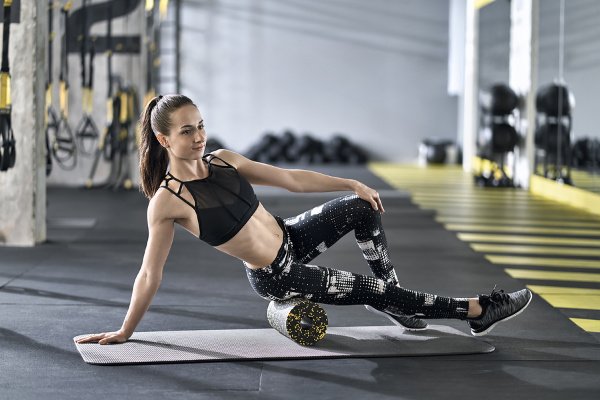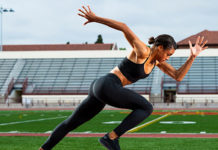
If you’re an avid runner, you may notice your legs need some extra TLC. There are certain things you can do to get your body ready for a workout and help it recover afterward. Foam rolling is one of the most valuable parts of a runner’s warm up and cool down, improving circulation, prepping your muscles for stretching and helping your muscles stay healthy and functional. If you want to feel better and run stronger, check out our post on foam rolling for runners, and 5 moves you should be doing!
What is Foam Rolling?
Foam rolling is a technique used for self-myofascial release, which means it’s used to release muscle tension or trigger points. It helps you self-massage by applying pressure to specific points on your body to help your muscles recover so they can return to regular function. When your muscles are functioning normally, they’re elastic, healthy and ready to perform at any given moment.
When you’re warming up for a run, foam rolling increases blood flow and releases muscle tightness that can interfere with proper running form. It increases circulation, loosens tight spots and primes your body to move. When you’re cooling down, foam rolling helps to flush out toxins, aiding with recovery. It has been found to improve your range of motion, flexibility and mobility, as well as reduce soreness and muscular tension.
What Are the Benefits of Foam Rolling?
- Reduces muscle pain and soreness by increasing blood flow and oxygen to the tissue.
- Increases your flexibility, helping to lengthen your muscles.
- Helps you manage stress by releasing tension in stress-related tight spots that are leading to discomfort.
- Increases your range of motion, strengthening and lengthening your muscles.
- Prevents injuries caused by tight muscles.
- Decreases your recovery time after a workout by recruiting fresh blood and nutrients to fatigued muscle groups.
What Kind of Foam Roller Should I Use?
When choosing a foam roller to use, there are a number of things to consider. The popularity of foam rollers has brought many products to the market, and while it can be helpful to have options, it can also make the process of choosing one confusing and overwhelming. Here are a few things to keep in mind when shopping for a foam roller:
1. Firmness. The firmness of your ideal foam roller will depend how tight your muscles are. If you’re just starting out with foam rolling, you may feel as though digging into sore muscles is extremely painful. If you’re willing to handle pain, you can go with a firmer foam roller, but if you want to start off light, opt for a foam roller with less firmness. If you start off with a softer foam roller, move up to a firmer one as your muscles get more used to the feeling.
2. Surface and Texture. The texture of a foam roller also determines its intensity. A foam roller with a completely smooth surface will be much more gentle than a foam roller with a spiky or grid-like surface.
3. Shape and Size. Long foam rollers (around 36 inches) are a good place to start if you’re a beginner foam roller because they’re more stable than shorter rollers. Shorter lengths (around 18-24 inches) are ideal for targeting smaller areas like your arms and calves, and the shortest length (4-12 inches) are great for portability or if you have limited workout space.
4. Tech. Foam rollers have gotten more tech-savvy over the years and some of them now include vibration. They help target trigger points for a deep tissue massage, and you can choose what level vibration each time you use it, depending on how your body feels and how much intensity you can handle.
Foam Rolling for Runners: 5 Moves to Try
1. Foam Rolling for Calves
Sit on the floor with your legs extended out in front of you, with the foam roller under your left calf. Rest your right foot on the floor with your knee bent, and use your hands to lift your hips off the floor. Roll from the ankle to below the knee, rotating your left leg in then out. Repeat on the other side.
2. Foam Rolling for Hamstrings
Sit on the floor with your legs straight out in front of you and place the foam roller under your thighs. Use your hands to lift your hips and roll from the knees to the glutes. If you want to increase the pressure, place your left leg over your right, and vice versa, rolling one leg at a time.
3. Foam Rolling for Iliotibial Band
Lie on your left side with the foam roller under your left hip. Cross your right leg over your left, resting your right foot on the floor with your knee bent. Prop yourself up on your left forearm and roll along your outer thigh from your outer hip to just above the knee. Repeat on the right side.
4. Foam Rolling for Quads
Lie face down on an exercise mat, with your forearms propping you up. Place the foam roller under your thighs and use your forearms to shift back and forth, rolling from the bottom of your hip to the top of your knee. For more pressure, lift one leg at a time, rolling the other.
5. Foam Rolling for Adductors
Lie face down on your exercise mat with your forearms propping you up. Extend your right leg out to the side with your knee bent. Place the foam roller on your inner right thigh area and use your forearms and left leg to shift your weight back and forth, rolling the inner right thigh. Roll from knee to hip and repeat on the other side.
Foam rolling is amazing for runners. Become stronger, more flexible and get healthier muscles with these foam rolling moves!













